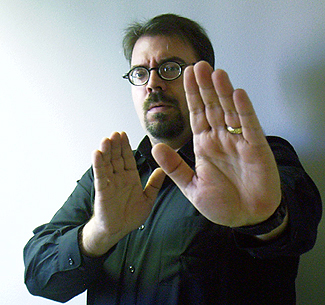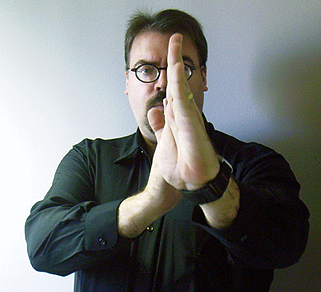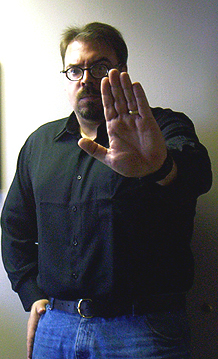its paid sponsors, whose products you need!
“Stay ‘unreasonable.’ If you
don’t like the solutions [available to you], come up with your
own.”
Dan Webre
The Martialist does not
constitute legal advice. It is for ENTERTAINMENT
PURPOSES ONLY.
Copyright © 2003-2004 Phil Elmore, all rights
reserved.
Maintaining Space and Weapons
Transition
By Phil Elmore
In my half of one of the
point-counterpoint-style editorials here at The Martialist, I wrote of one
encounter with a street person after parking my car downtown:
In Wing
Chun we are taught that a potential threat must not be allowed to close
within striking distance of you. You must attack the opponent
preemptively when he enters this range. When approached by someone
whom you do not trust, we are taught, you must put up your hands and
maintain a safe distance. As the panhandler approached, my first
thought was that I must, at any cost, keep him outside that distance
or
else I would have to strike him, as I did not want him approaching me.You see, every panhandler you
meet IS a potential threat to your health and your well-being. Under
no circumstances whatsoever should you allow a street person to approach you…
…I pointed at him, bringing my rear hand up
in a subtle approximation of the double Wu Sau guard that is the default hand
position in Wing Chun Kung Fu.“Step away,” I hissed.
Now, I’m not describing this because I think
I’m cool or because I think I have the ability to put the Fear of Phil into
random strangers. I was simply enraged and I spat at this beggar
with a hostility I did not realize I possessed. I reacted instinctively
but my instincts were, in this case, developed by training that simply took
over under stress. I was pleased that when I needed it, I did not have
to think about it. That is the goal of training to defend yourself for
real-life problems.
Some of the armchair experts across the Internet
accused me of overreacting, of “dropping into a Kung Fu stance” to
deal with a relatively benign situation. In so doing, these critics
betrayed their ignorance because the basic hand positioning to maintain
personal space is fairly universal.
I’ve seen the stance referred to as a “I don’t want any
trouble” position, a “fence,” and a “de-escalation
stance.” Whatever the terminology, the basic concept is the
same. When you are approached by someone who represents a potential
threat to your person be he a panhandler, a drunken barfly, or an
incongruously aggressive stranger demanding the time you must keep that
person outside striking distance to avoid making yourself a potential victim.
The basic “Hey, stop, I don’t want any trouble”
position is a bladed (angled) posture in which the hands are up, staggered,
palms open. This does indeed look
almost identical to the double Wu Sau guard. The arms create distance
and provide a protective barrier for your body (and, more specifically, your
centerline). The body language is clear: Do not come any closer.
The open palms are less aggressive than vertical hands in appearance, but open-hand blows can be
delivered easily from either stance.

Maintaining space while deescalating if
possible. Open-
hand blows can be delivered easily from this posture.

Wing Chun’s double Wu Sau (“Guarding
Hand”) posture. It’s
the same stance with the hands turned vertically. The body
is more squared to the opponent, but the idea is the same.
From this hands-up, palms-open, bladed posture, you have the
option to deliver physical strikes if you must defend yourself. You also
may choose to transition to a weapon (thus escalating the force used in the
scenario). The most common justification for making this transition
would probably be facing multiple opponents, in which case a “force
multiplier” could be seen as a rational necessity on your part as
the defender. (I’m not a lawyer, so don’t take this as legal
advice. It’s safe to say that if you use a weapon in a violent
altercation, you’re going to have to answer for your actions in court.)
If
you carry a knife or a firearm on your strong side in your waistband,
in your front pocket, or behind your strong-side hip the transition is as
simple as dropping the rear hand to index the weapon. Simply preparing
to draw your weapon can be done relatively discreetly, too. Here I am
maintaining space with my weak-side hand while indexing the tactical folder in
my right front pocket. Provided you don’t slap yourself like a
gunslinger going for his piece, this needn’t be perceived as provocative until the
weapon is actually drawn.

Indexing a tactical folder in the pocket
while maintaining space and protecting
the body’s centerline.
The postures shown here are
merely starting points, of course. What you do from the decision to
attack (or to make the transition to a weapon) is up to you and will depend on
your individual training. At that point, all bets are off. What’s
important to remember is that, if at all possible, you must keep potential
opponents outside the distance at which they can reach you to do you
harm.
In another article here at The Martialist, I
spoke of maintaining space when asked for the time in public:
If you’re obviously wearing a watch, you have two choices
when asked for the time. You can be rude and refuse to give it, or you
can comply with the request. The problem is that when approached on
the street by a stranger, there is a chance not a great one, but
a real one nonetheless that someone who asks you for the time is trying
to distract you in order to assault you. Think about it: when
you look at your watch, you typically look down at your arm, making
you an easy target.If someone you don’t know comes up to you and asks you for
the time, you can easily minimize your risk. Step back
casually, away from the stranger, preferably blading your body as you do so.
Raise your arm rather than lowering your head, keeping that arm well
away from your body and between you and the other person. In this way
you can read the time while keeping your guard up.Practice doing this so it looks casual rather than
confrontational. There’s no need to drop into your Daniel-san crane
stance and fire off a flurry of snap kicks just to tell someone they’re late
for an appointment.
Do this properly and you will see the similarities between
it and the posture(s) already described. The rear hand could be relaxed,
or it could be brought up casually to protect the centerline. Pretend to
be scratching your chest or simply talking with your hands, if you must, but
bring that rear hand up if needed.

Step back and raise your arm to
read the time. This
puts that arm between you and the other person,
keeping your vision directed up and forward.
These
are simple concepts and nothing really new. It does not hurt, however,
to be reminded of them.
Use your body and your
body language to maintain space for self-defense.
